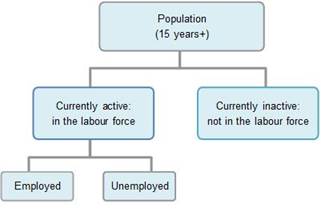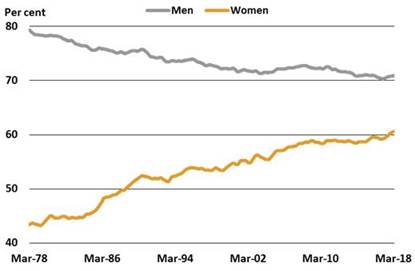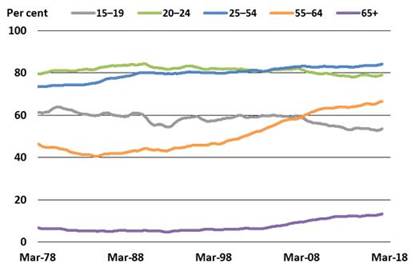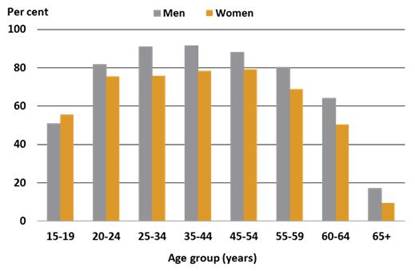Updated 24 May 2018
PDF version [339KB]
Penny Vandenbroek
Statistics and Mapping Section
Introduction
This guide provides a brief overview of the labour force, an
introduction to the key concepts and terminology, and lists relevant data
sources. This is one in a series of statistical quick guides, designed to
provide a basic understanding of Australian labour market data. Other guides
include unemployment
and employment,
which are available from the Parliamentary
Library website.
What is the labour force?
|
The labour force is the sum of employed
people and unemployed people.
|
The International
Labour Organization (ILO) defines employed
people as all those of working age (e.g. 15 years and over) who during a
short reference period engaged in any activity to produce goods or services for
pay or profit, as well as some persons who were temporarily absent from work.
The unemployed
are people of working age who were without work during this same reference
period, but were actively seeking work and available to start work. A third
group of people, those not
in the labour force, round out the three mutually exclusive categories that
form the labour
force framework (see diagram below).
Labour
force framework

Source: ABS, Labour Statistics: Concepts, sources and methods, 2013,
cat. no. 6102.0.55.001
Common terms
The labour force is often referred to as the ‘work force’ or
the ‘active population’, and the participants may be described as those who are
‘currently economically active’. In Australia, data on the labour force
usually, but not always, relates to people aged 15 years and over. Labour force
data is sometimes presented with (or available only to) an upper age limit,
which is broadly the retirement age (e.g. 15 to 64 years). The data may then be
referred to as ‘the working age population’ or similar descriptor. Labour force
data may be further stratified, through the use of a ‘prime working age’ group
(e.g. 25 to 54 years).
What are the key measures?
Labour force status
The Australian Bureau of Statistics (ABS) conducts a monthly
Labour
Force Survey. This household survey is designed to produce key labour
force estimates from a sample of approximately 50,000 people. Each month the ABS produces
estimates of the labour force and releases trend, seasonally adjusted and original
data. Data is available by labour force status (i.e. employed, unemployed and
not in the labour force) and age, sex, social marital status, state or
territory of residence, full-time educational attendance, plus a range of other
variables related to the employed/unemployed.
Participation rate
The Reserve
Bank of Australia (RBA) describes the participation rate as an important
indicator of the supply of labour. It is used to measure the share of the
working-age population either working or looking for work (i.e. employed or
unemployed).
|
The participation rate is the labour force
(aged 15 years and over) expressed as a proportion of the civilian population
for the same age group (e.g. 15 years and over).
|
Graph 1 shows the participation rate by sex and provides an
indication of the changes that have occurred in men’s and women’s labour force
participation over time.
1. Labour force participation rate—trend

Source: ABS, Labour force, Mar 2018, cat. no. 6202.0
Graph 2 shows participation rates by selected age groups and
provides insight into the changing workforce landscape. There has been a
notable increase in the participation rate of people aged 55 to 64 years over
the past twenty years. The participation rates for the oldest age group have
also more than doubled over the past twenty years.
2. Labour force participation rate by
selected age groups—annual average

Source: ABS, Labour force, detailed – electronic delivery, Mar 2018,
cat. no. 6291.0.55.001
Graph 3 provides annual average participation rates for
selected age groups in 2017. The rates highlight the changing age structure of
the workforce as people enter and exit the labour force. It also shows women’s
overall lower participation in all age groups, except the youngest cohort.
3. Participation rate by selected age groups,
2017—annual average

Source: ABS, Labour force, detailed – electronic delivery, Mar 2018,
cat. no. 6291.0.55.001
The Parliamentary Library’s Monthly Statistical Bulletin
provides regular updates of the participation rate (based on ABS data), see ‘1.3
Labour force’.
Where do I find regional data?
Labour
force, detailed – electronic delivery, cat. no. 6291.0.55.001
provides monthly labour force data for the smallest available geographic areas
(excluding the Census), see: Table 16, Table 16b (annual average series) and
Data Cube RM1. Most of the data is from the original (unadjusted) series and, due
to the small sample sizes, the sampling errors with some estimates may be quite
high. The use of an annual average is recommended, as is caution when
interpreting the data.
Statistical Area Level 4 (SA4) or ABS ‘Labour market
region’
SA4s
are designed for the dissemination of labour force estimates and to reflect key
labour markets within each state and territory. They cover 87 spatial areas
across Australia. For Library clients, a correspondence between Commonwealth
Electoral Divisions and selected geographies (including SA4s) is available via
the Library portal,
see ‘Your electorate’ > ‘Population’.
The Department of Jobs and Small Business publish
selected ABS regional labour force data (SA4) on their Labour Market Information Portal,
including labour force status and the participation rate. The portal includes
interactive maps and limited time series data.
Where do I find data for smaller
geographic areas?
The five-yearly Census of Population and Housing
provides data for small statistical areas, including Commonwealth Electoral
Divisions (2016 boundaries). The most recent Census was held in August 2016. The
General
Community Profile series provides selected information, including:
labour force status (by age and sex), participation rates and the labour force
status of parents by the age of their dependent children. Caution should be
used when interpreting the data, as it relates to a specific week in August
2016 and may not reflect the current labour market situation.
As a by-product of producing the quarterly unemployment
estimates for Small
Area Labour Markets, the Department of Jobs and Small Business also publish
smoothed labour force estimates for Statistical Area Level 2 (SA2s, geographic
areas smaller than SA4s) and Local Government Areas (LGAs). While these
estimates cannot be used to produce a participation rate, they can give a broad
indication of the size of the labour market and changes in this level.
Where do I find data for changes in
the labour force (flows)?
The ABS captures information about the changing nature of
people’s labour force status in the Gross
changes (flows) series (see Data cube GM1). This series provides estimates
of changes in status from the previous month to the current month. For example,
moving from being unemployed to being employed. The data is available by age,
sex and state/territory. Caution should be used when interpreting the estimates
as the sample represents about 80% of the population value, the data is not
adjusted for seasonality (i.e. original series) and some bias may occur in the
estimates due to the monthly movements matching process.
Where can I find international
comparisons?
OECD
Data provides summary labour force indicators, including comparison participation
rates, for OECD member countries.
For copyright reasons some linked items are only available to members of Parliament.
© Commonwealth of Australia

Creative Commons
With the exception of the Commonwealth Coat of Arms, and to the extent that copyright subsists in a third party, this publication, its logo and front page design are licensed under a Creative Commons Attribution-NonCommercial-NoDerivs 3.0 Australia licence.
In essence, you are free to copy and communicate this work in its current form for all non-commercial purposes, as long as you attribute the work to the author and abide by the other licence terms. The work cannot be adapted or modified in any way. Content from this publication should be attributed in the following way: Author(s), Title of publication, Series Name and No, Publisher, Date.
To the extent that copyright subsists in third party quotes it remains with the original owner and permission may be required to reuse the material.
Inquiries regarding the licence and any use of the publication are welcome to webmanager@aph.gov.au.
This work has been prepared to support the work of the Australian Parliament using information available at the time of production. The views expressed do not reflect an official position of the Parliamentary Library, nor do they constitute professional legal opinion.
Any concerns or complaints should be directed to the Parliamentary Librarian. Parliamentary Library staff are available to discuss the contents of publications with Senators and Members and their staff. To access this service, clients may contact the author or the Library‘s Central Entry Point for referral.